The other day, I showed you that magnificent box of M. Heminway & Sons silk – a goodly collection of vintage silks from the turn of the 20th century. The more I think about this treasure, the more excited I am about it! Here, I’d like to show you some of the linens that were in the box…
These linens are certainly “vintage” – they’re downright antiques. Some are embroidered in part, some are not. Some are in fairly good shape and might be salvageable, but some probably can’t be salvaged. Below, you’ll see some photos of only some of the linens, actually – there are more than pictured here, but this is a good selection of the types of linens in the box.
Many of the pieces are of the same weight fabric – a light, fine linen with a smooth “hand” (or surface feel), but others are coarser linen and one even looks like a cotton sateen, the type of fabric used for Mountmellic embroidery. And there are different types of designs on some of the linens – especially on the coarser ones. These, I don’t think, were necessarily used for “Society silk” styled embroidery, but for other projects – maybe just practice?
Let’s take a look – and if you have any insights, do feel free to share them!
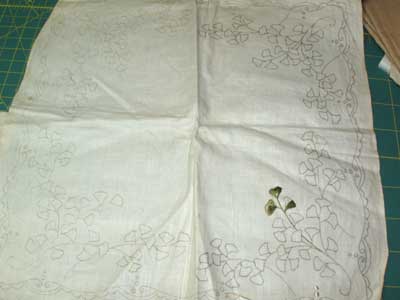
This is rather a fine weight linen, with a leafy design printed on it. Embroidery was begun on one corner.
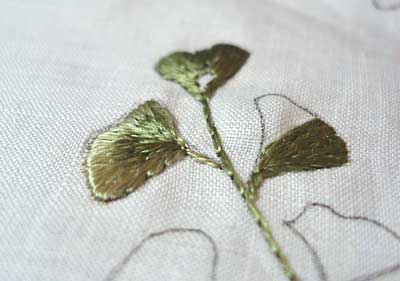
The embroidery for the filled areas is worked in a shading technique – long and short stitch – and the stems are worked in stem stitch. Isn’t the sheen of the silk just beautiful?!?
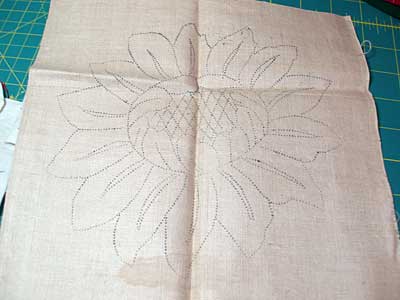
This is a piece of rather coarse linen. You can see that it is pretty well stained and marked with age. I suspect that the embroiderer actually put the pattern on herself, via a prick-and-pounce method of transfer. The pounce must have been either damp or actually an ink of sorts. In old books, especially books on ecclesiastical embroidery, there are some “recipes” for ink that is applied in a way similar to the prick-and-pounce powder method method, and I think that’s what this is. Why do I assume she didn’t buy the piece with the design already on it? Read on, and I’ll get to that point further down…
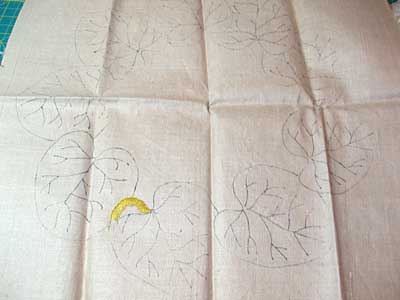
This is another piece of linen that’s relatively coarse, but not as coarse as the linen in the previous photo. The design on this one looks preprinted, and the embroidery was begun in a heavier silk (called “rope” – there’s a good bundle of this silk in the box).
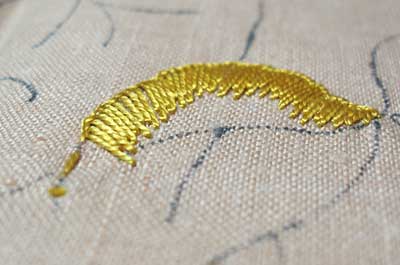
The embroiderer was stitching the edges of the leaves in buttonhole stitch.
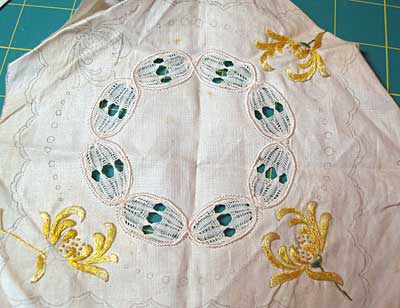
This is another piece of finer linen – very thin stuff. I suspect that the piece came with the drawn thread areas already done, and with the embroidery design printed on it. This was obviously a set, because there are a couple more pieces in the box, just like this, with different embroidery designs around the drawn thread area.
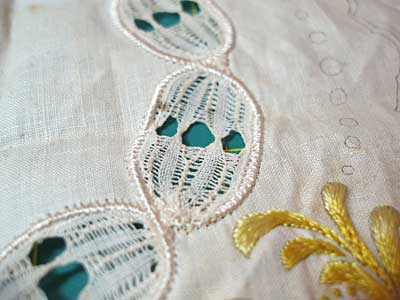
You can see a close-up on the drawn thread area here. Though it is visually interesting over all, the drawn thread design is not worked very neatly. The tips of the ovals are jammed with threads. Still, the inside parts of the ovals are really incredible – teeny tiny detail work here.
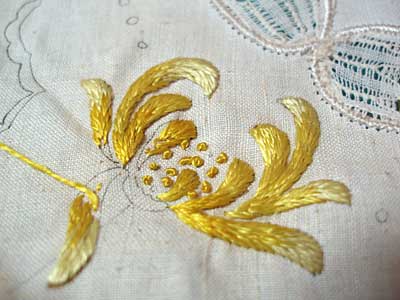
You can see the graduated shades in the stitching here, and the luster of the silk.
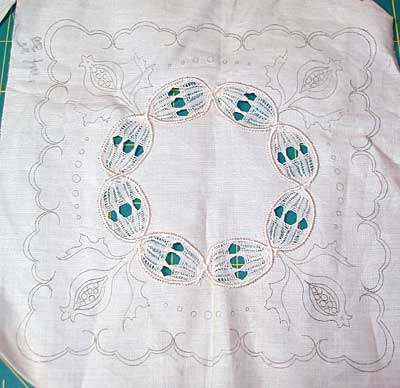
This piece is from the same set, but instead of flowers, the design around the outside features pomegranates.
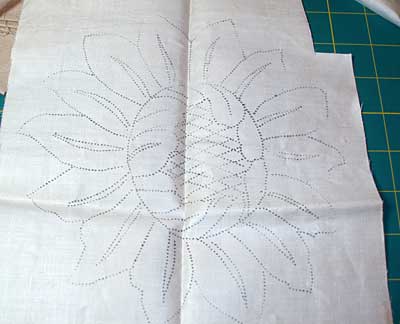
This is the same design as the first coarse linen up above, and the fabric looks to me more like a cotton sateen – it’s shiny, and the weave looks like a sateen. Hence, my reasoning for thinking she transferred these two designs herself, because they are on completely different types of fabric, and though the designs are the same, they have a few “blotches” in different places. It’s a neat design – it has the look of some of the flowers you’ll find in William Morris’s textile designs.
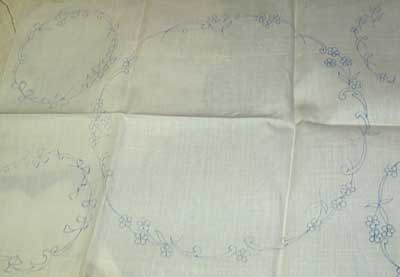
Here’s another piece of fine linen, with a design typical of “Society silk” or Silk Art Embroidery. There’s a larger doily, with several small ones – sort of like coasters. The design is preprinted in blue.
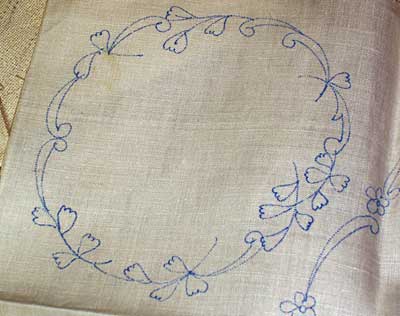
The small circles have different designs around them – they aren’t all exactly the same. I think there were two of one pattern and two of another, but they all “work” together as a matching set.
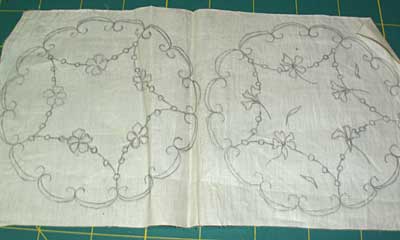
Here’s another set of small doilies. The edges of these could be worked in a buttonhole or a satin stitch, then the rest of the fabric could be cut away.
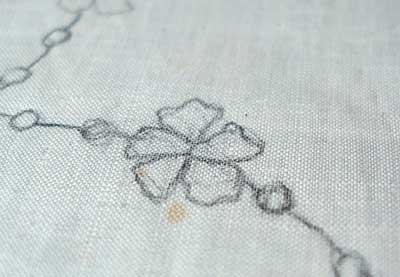
The strange thing about this set is that it looks as if someone went back over the design with pencil, either to darken it up, or to put in guides for stitching. Either that, or perhaps a ghost image was printed on the fabric at the same time. I’m wondering about spot removal on some of these – I wouldn’t want to remove the design, but I’d like to get rid of some of the spots…
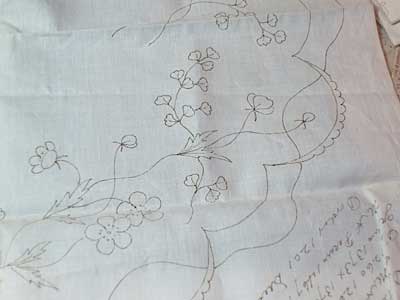
This is another pre-printed linen, on a finer weight of linen, but printed in yet a different style when compared to the other linens above.
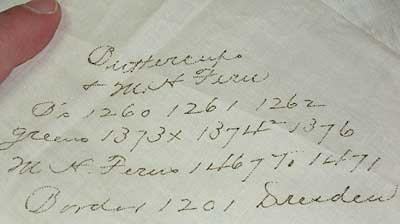
What I really like about it is the information on the corners – directives for types of stitching and colors, I think.
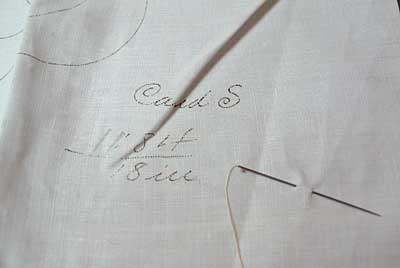
There’s also what looks like a design or pattern number, and a needle still stuck in the fabric.
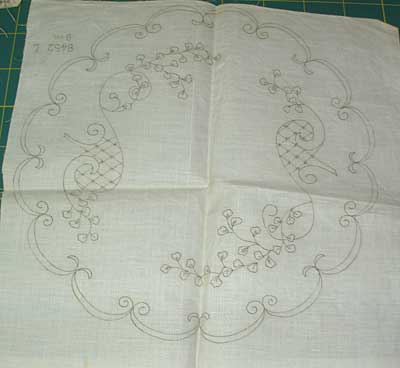
This piece is perhaps my favorite in the whole box – not just because I think the pattern is very pretty, but also because it is in the best shape. I think it IS salvageable, and it would be worth embroidering in the same style, using the silks from the box. I’ve put that on my List!
Some of the pieces had some really pretty embroidery on them, though none of it was finished. Some bits of embroidery look like practice pieces, while others were projects underway but never completed. I’ll show you some of those a bit later, too!
So what do you think? Worth trying to clean some of these up to stitch? Do you think they’d hold up? I certainly think the patterns are worth tracing on many of them, that’s for sure! Some of the designs are very pretty and delicate – others are bold and beautiful. I may have to devote some time to that!







Hi Mary,
I've been anxious to see these. They are all nice, however I'm not fussed on those openwork areas. I think the pieces are worth working. I remember my Mum doing that close buttonhole stitch around the edges of petals and leaves.
Bleach pen, perhaps for the white/light linen spots? I don't know…but even with spots, they are worth working in all honor to the original owner.
Call it a badge of distinction…
Hi Mary,Regarding those spots, what I normally do if i do not want to wash the item, I take an earbud and wet it with water. I put the item on a folded towel to absorb water, and then carefully wet the spot, working from the outside inwards. If the water alone does not do the trick, put a little liquid detergent on the earbud and work it in the same manner. To get rid of the detergent take another bud
with clean water move the item to a dry part on the towel and repeat
. Of course it is always wise to try this procedure on a corner first. Hope I could have been of some help.
Regards, Elza Bester Cape Town
I've "inherited" a stack of vintage linens that are all finished, and my question is What do I do with them? The friend who gave them to me was just going to take them to Goodwill. I've used some of the table runners, but there are so many things. They need to be valued. What do other people do with these lovely things?
Nancy Larsen
What a great find! Are you going to make a pattern of these designs if you can't get the spots out? I'm not sure about copyright laws but these seem to be old enough to make copies of at least for yourself. I would try to make the last one that you liked best and make patterns from the others. Thanks for sharing these pictures with us.
First off, thank you for visiting my blog. What a wonderful box of inspiration you received and how fortunate the piece you like best can be salvaged. I can picture that design and some of the others being reinterpreted in paper filigree… you never know where you'll find new ideas!
I suspect these were meant to be scarves–they used to put them on everything from chair backs and arms to dresser and table tops. My grandma used to crochet beautiful edgings to complete them. They were used at home, made for daughters' hope chests and given as gifts. This treasure you received might even have been an accumulation from more than one generation that was passed down as eyesight failed, etc. Anyway, I hope you keep and finish them. There are people who specialize in cleaning/repairing old textiles for museums and offer their techniques on the internet, which might be helpful.
Still looking at those drawn thread areas on your new acquisitions. Were those done on another piece and then added to the to-be-embroidered pieces, with the portion under them (after adding)then cut out? Or how? The grain….
What great treasures! If they were mine, I'd be working them in colour fast thread, then cleaning them, then making them into things like bags, handkerchief sachets, cushion covers etc. A lot of those markings will come out by just washing & bleaching in the sun. I agree, I think they were meant to be chair covers. As for the drawn thread section, it is definately another piece which is appliqued on . The grain is totally different from the base fabric. Beautiful pieces, can't wait to see what you do with them
What an amazing find! I always scour antiques fairs for vintage linens, but they're getting increasingly difficult to find. I've never come across anything close to your box, though.
Exciting stuff, to my mind, and rather unusual designs; most of what still exists from the 'silk' era is smaller and less bold than many of these nice 'throws'.
I'd copy (trace, that is) the patterns and then wash the linens themselves, especially for those that are actually linen. A lot of that spotting looks like (at least over the computer) insect damage (read insect pee)and rather than actual damage-damage and a lot of that will come out with a regular wash, which would also remove other pollutants that have accumulated over the years: dust, wood or coal smoke, and whatnot.
Linen is a very durable fiber and you are very unlikely to ruin it by washing….I usually use actual soap for said washing rather than modern detergents which have brighteners and all sorts of other chemical additions that certainly weren't designed to make a fabric last longer. Some of those are actually bad for longevity and some have never been tested for anything; who knows what they will do in 20 years? I'd try laying them in the sun to lighten them if you think they need it rather than using any sort of bleach.
Another reason to wash them is that some of the old inks/dyes used for marking and/or printing fabric were made with iron filings, along with a number of other ingredients, and the iron will eat away at the fiber as the years go by. You've probably seen old quilts where the dye just 'ate' the fabric along lines where it was thickly applied to get a dark line….that's what you want to avoid. Especially the ones you thought to be handmarked would be likely suspects: right up into the 1940s some were still using walnut hulls for such marking inks—unfortunately, the hulls were usually boiled in iron vats, so again the iron issue…. Linen holds up to that sort of damage better than either cotton or wool but sooner or later, they all succumb to iron exposure if it's there.
Another thing, if fabric doesn't hold up to a washing it likely won't hold up to being stretched on a hoop or frame, either. And once it's clean and pressed, then you can reapply the designs with pencil, which is a fairly benign substance, although I do keep actual graphite pencils for such work, rather than the synthetic-lead ones.
I like Carlie's idea to copy these designs (and maybe sell them??); several of them are very different from what we often see on old textiles. You can write me down for the one with the pomegranates! And although it is less uncommon than some of the others, I love the one that's all maidenhair fern leaves. Sweet, sweet.
I notice that several of the pieces have maidenhair leaves; I wonder if the person especially liked them, or whether they were just in fashion, or maybe she bought mostly from the same designer/supplier, or ???
Anyway, quite a treasure. Congratulations!
These are all great finds Mary. I would certainly copy the patterns before I tried to do anything with them. About cleaning them…something is lurking in the back of my mind that I've read about using lemon juice on the 'spot' and then placing the item on the grass outside in the sun. Perhaps a search on the internet would give you some ideas of what you could do to restore them?
They are all lovely Mary. I like the last one as well. I would probably copy the patterns and put them on a fabric that is in better condition and fabric that you prefer.
Hi Mary, what lovely pieces. I was just wondering what you decided to do with them as far as washing the spots out. My experience has been that the pre-printed designs were made to wash out in the first wash ~ I don't think they will still be there if you try to immerse them in anything resembling soap and water (or even just plain water).
In my research for my book (Silk Art Embroidery, A Woman's History of Ornament & Empowerment), I purchased many, many pieces just like this that had been worked but never washed, and you could still see the design under the floss. When soaked, the design comes right out.
As far as the patterns themselves, the ladies could purchase the linens to be worked with the design already stamped; buy a Stamping kit and either copy the patterns from the many embroidery books; or they could design their own pattern and stamp them on whatever type of linen they wished. Some of the companies also offered them for sale at a higher price with the embroidery already started, which could explain the partly done embroidery on some of your pieces.
You are correct that the pieces could be purchased with the drawnwork and/or hemstitching already done. This was especially true of the smaller fine white linen teacloths that were so popular for teatime. I have several catalogs from which dealers actually purchased their stock of items to sell, and there are many different types of pieces such as this.
Also, the difference in the fabric and the designs is because in the beginning of the silk art embroidery movement in America (in 1877), fine white linen was the norm for most of the table linens. Closer to the end of the approximately 33-year period (1877 to 1910-1912 or so), they began to use the coarser, heavier fabric. They called the different fabrics “ticking,” “brown burlap,” “grey crash,” “Tan Art Cloth,” to name a few. The designs also turned away from the pure realism of the beginning time period to include more abstract "Arts & Crafts" and "William Morris" type motifs. In many cases, these linens were also shaded so that the volume of embroidery necessary to finish the piece was much less then from years past. Often they only worked the edges of these designs.
Also, they offered MANY different types of floss and the motifs look totally different when worked with differnt types ~ Richardson's sold "Filo," "Sicilian," "Grecian," "Rope Silk," "Wash Embroidery Twist," "Honiton Silk" (especially for use in Honiton Lace work), or "Mountmellick Silk." There are also different sizes of silk floss for different types of items ~ something that was used on the table had to be more sturdy, while a piece made to frame (which came into popularity in 1901) could be a little less sturdy and therefore more delicate floss could be used.
Ecclesiastical embroidery was very popular as mentioned, and though I’ve seen many patterns in the embroidery books, I’ve only seen one piece in real life (which I found after my book was published, so it’s not in the book). I’ll post a picture of it on my website if you would be interested in seeing it.
By the way, many of your pieces have the very popular motif of maidenhair ferns stamped on them. Also, all of these are table linens. It was very common to purchase them in sets for the whole table. They consisted of a centerpiece and matching doilies.
Hope some of this helps. If I can answer any more questions, please feel free to contact me. You can do so through my website, http://www.societysilkembroidery.com.
Donna Cardwell